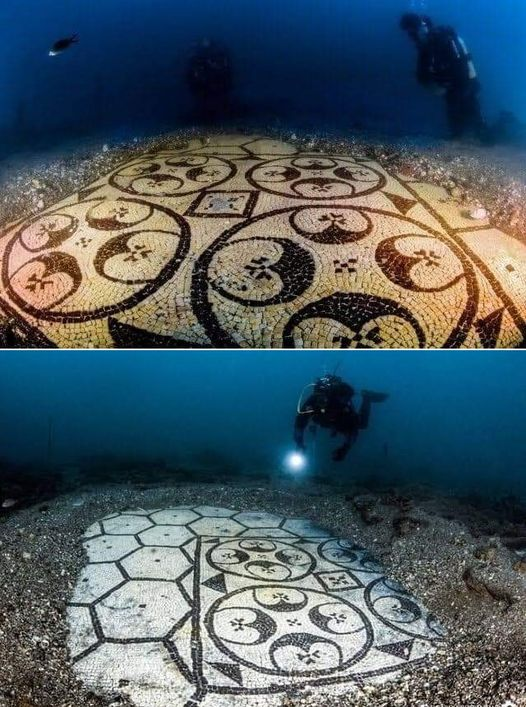
The sea holds many secrets—some sunk by storms, others buried by time. But few are as eerily beautiful, as quietly profound, as what lies just beneath the Tyrrhenian Sea off the coast of Italy: a forgotten floor, a mosaic masterpiece lying not in a gallery or a museum, but cradled by silt and seaweed, guarded by silence and pressure.
This is Baiae—ancient Rome’s drowned playground, now a sunken city of ghosts and opulence. And here, more than 1,700 years after it fell to the sea, a floor still whispers the stories of those who once danced above it.
The Mosaic Awakened
Imagine the moment: A diver descends into the turquoise stillness, his breath rising in silver ribbons. Light from his torch cuts through the blue murk, scanning the seabed. Suddenly, shapes emerge—circles within circles, black vines swirling like constellations, delicate tiles gleaming with ancient precision.
It’s not just stone. It’s geometry with a soul. Art underwater, resisting time.
The floor he uncovers belonged not to a humble home, but to a Roman villa—a domus of luxury, a sanctuary of marble and music, once visited by senators, generals, and possibly emperors. The mosaic patterns, both mathematical and organic, still pulse with intent. They were never meant to be seen from above like this—but rather felt beneath the feet of someone wrapped in silk, bathed in perfume, surrounded by the sweet scent of spiced wine.
The ocean, it seems, remembers what the land forgets.
Baiae: Rome’s Sunken Sin City
To understand this mosaic, we must first resurface—back in time. During the late Republic and well into the Empire, Baiae was the Las Vegas of the Roman world. Situated on the northern coast of the Gulf of Naples, it was a resort of unimaginable extravagance. Emperors like Augustus, Nero, and Hadrian built sprawling villas here, complete with steam baths, libraries, pleasure gardens, and infinity pools that seemed to blur into the sea.
Seneca the Younger once scorned Baiae as a place of “luxury and vice,” where virtue came to drown. And drown it did—both metaphorically and literally.
By the 4th century CE, volcanic activity beneath the earth shifted the land. The region experienced a phenomenon known as bradyseism—where the earth slowly rises and falls due to magma chambers swelling and collapsing below. Over centuries, Baiae sank—its columns swallowed inch by inch, its fountains drowned without ceremony.
What was once laughter and luxury became seaweed and silence.
Archaeology Underwater: The New Frontier
The rediscovery of Baiae’s mosaics marks one of the most extraordinary underwater archaeological efforts in Europe. Divers, historians, and scientists have worked for decades to map what is now the underwater archaeological park of Baiae—a protected zone where ancient villas, thermal baths, and temples remain eerily intact beneath just a few meters of seawater.
The mosaic in the pH๏τo above—swirling black patterns set into pale stone—was uncovered not long ago, and has since captivated the global community. No longer merely artifact, it became symbol: of survival, of beauty preserved in silence, of the ancient world not gone, but merely sleeping.
But preservation here is a race. The sea is both protector and predator. Without constant monitoring, these floors may be lost again—this time not to history, but to erosion and pollution.
Who Walked Here?
It’s a question that pulses through every tile: who walked this mosaic?
Perhaps it was a noblewoman in an ivory stola, her sandals clicking against the stone as she recited lines from Virgil. Maybe a young officer, just returned from the Germanic front, drank his first sip of wine here while his lover ran fingers across the cool floor. Or a philosopher, weary of politics, stood in the atrium and let the patterns underfoot guide his thoughts toward the cosmos.
This floor was once a stage for a thousand forgotten performances. Now it lies in quiet dignity, the last surviving witness.
The Emotional Undertow
There’s something profoundly emotional about seeing beauty endure beneath collapse. The fact that this mosaic still exists—not in a palace, not in a curated exhibit, but underwater—is like reading a poem that survived a fire.
It’s humbling.
We live in an age of instant forgetting. Digital things vanish with the flick of a server. Cities are bulldozed. Cultures evaporate under the weight of noise. But here, a piece of Rome lies intact, reminding us of what once mattered: form, pattern, symmetry, devotion to beauty.
There is sadness here, yes—but not despair. The mosaic does not mourn its drowning. It simply waits.
A Mirror to Ourselves
Baiae is often compared to Atlantis—not because of myth, but because of metaphor. It is a mirror city, showing us what happens when indulgence meets impermanence. It reminds us that even empires can sink. That pleasure can be both fleeting and eternal.
And yet, the mosaic at the bottom of the sea says something else too: that art can outlive us. That even when the structures crumble, the design remains. That beauty, once laid down with care, becomes a kind of immortality.
What the Sea Keeps, and What It Gives Back
In recent years, drone footage and submersible imaging have allowed more people to glimpse Baiae’s secrets. But no pH๏τo, no scan, can replicate the feeling of discovery—of being the first in centuries to run a hand across tesserae still firm in their setting.
The divers who found this mosaic didn’t just document a relic. They uncovered a relationship—between past and present, between stone and soul.
It begs a question we should all ask: What parts of our world will survive us—and who will care enough to remember?
So the next time you stare at the sea and imagine only water, remember this: Somewhere below, in the cold and dark, a mosaic might still be waiting. A floor that once knew laughter. A home that once held life.
And perhaps, like this one in Baiae, it will one day rise again—not through force, but through care. Through wonder. Through the sheer refusal of beauty to disappear.


